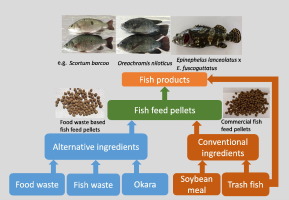当前位置:
X-MOL 学术
›
Sci. Total Environ.
›
论文详情
Our official English website, www.x-mol.net, welcomes your feedback! (Note: you will need to create a separate account there.)
Use of food waste, fish waste and food processing waste for China's aquaculture industry: Needs and challenge
Science of the Total Environment ( IF 9.8 ) Pub Date : 2017-09-18 , DOI: 10.1016/j.scitotenv.2017.08.321 Wing Yin Mo , Yu Bon Man , Ming Hung Wong
Science of the Total Environment ( IF 9.8 ) Pub Date : 2017-09-18 , DOI: 10.1016/j.scitotenv.2017.08.321 Wing Yin Mo , Yu Bon Man , Ming Hung Wong

|
China's aquaculture industry is growing dramatically in recent years and now accounts for 60.5% of global aquaculture production. Fish protein is expected to play an important role in China's food security. Formulated feed has become the main diet of farmed fish. The species farmed have been diversified, and a large amount of ‘trash fish’ is directly used as feed or is processed into fishmeal for fish feed. The use of locally available food waste as an alternative protein source for producing fish feed has been suggested as a means of tackling the problem of sourcing safe and sustainable feed. This paper reviews the feasibility of using locally available waste materials, including fish waste, okara and food waste. Although the fishmeal derived from fish waste, okara or food waste is less nutritious than fishmeal from whole fish or soybean meal, most fish species farmed in China, such as tilapia and various Chinese carp, grow well on diets with minimal amounts of fishmeal and 40% digestible carbohydrate. It can be concluded that food waste is suitable as a component of the diet of farmed fish. However, it will be necessary to revise regulations on feed and feed ingredients to facilitate the use of food waste in the manufacture of fish feed.
更新日期:2017-09-20


























 京公网安备 11010802027423号
京公网安备 11010802027423号